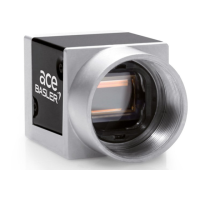AW00097603000 Color Creation and Enhancement
Basler aviator GigE 121
8.3.4 Color Adjustment
On all color cameras equipped with a Bayer pattern filter the pixel values output from the sensor
reside in the RGB color space.
The camera’s color adjustment feature lets you adjust hue and saturation for the primary and
secondary colors in the RGB color space. Each adjustment affects those colors in the image where
the adjusted primary or secondary color predominates. For example, the adjustment of red affects
the colors in the image with a predominant red component.
The RGB Color Space
The RGB color space includes light with the primary colors red, green, and blue and all of their
combinations. When red, green, and blue light are combined and when the intensities of R, G, and
B are allowed to vary independently between 0% and 100%, all colors within the RGB color space
can be formed. Combining colored light is referred to as additive mixing.
When two primary colors are mixed at equal intensities, the secondary colors will result. The mixing
of red and green light produces yellow light (Y), the mixing of green and blue light produces cyan
light (C), and the mixing of blue and red light produces magenta light (M).
When the three primary colors are mixed at maximum intensities, white will result. In the absence
of light, black will result.
The color space can be represented as a color cube (see Figure 36 on page 122) where the primary
colors R, G, B, the secondary colors C, M, Y, and black and white define the corners. All shades of
gray are represented by the line connecting the black and the white corner.
If color adjustment is not available, activate the "Full" camera description file.
For more information, see Section 10.20 on page 260.
For the color adjustments to work properly, the white balance must be correct.
See Section 8.3.1 on page 113 for more information about the white balance and
see Section 8.3.5 on page 126 for an overall procedure for setting the color
enhancement features.
Although color adjustment can be used without also using color matrix
transformation, we nonetheless strongly recommend to also use color matrix
transformation to make full use of the camera’s color enhancement capabilities.
See Section 8.3.3 on page 117 for more information about color matrix
transformation.
